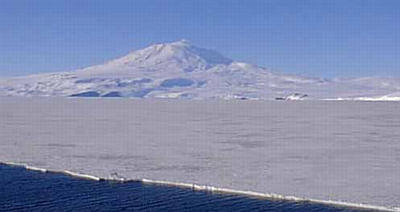12 February, 1999
February 12, 1999
Greetings from the Ross Sea! Yes, we are finally underway. We left McMurdo
Station at about 6:00 p.m. this evening. On our way out, we saw some seals
and
a minke whale! Unfortunately, I don't think the pictures of the whale turned
out too well. We also went right past Mt. Erebus, which is a volcanic
mountain
located not too far from McMurdo Station.
Not too long before we left, it was explained to me that the dock we were
attached to while in McMurdo was called the Ice Pier. It is made of ice and
rocks, and held to the land with large cables. Evidently, the Ice Pier has
lived a long and productive life but needs to be replaced. So immediately
after our departure, a coast guard ship was going to come in and tow it out to
sea. While the old Ice Pier is melting, a new one will be constructed so that
it will be ready for ships next season.
So, what kinds of buildings did you think would be found at McMurdo Station?
It would probably help if you knew that McMurdo Station is the largest
research
station on the continent of Antarctica. It was first established in 1956,
covers nearly 4 square kilometers of land, and has more than a hundred
buildings! McMurdo Station gets its name from McMurdo Sound, which was named
after Lt. Archibald McMurdo. Lt. McMurdo was on Sir James Clark Ross' ship,
Terror, in 1841. What geographic location was named after Captain Ross?
McMurdo Station is well equipped -- with a church named Chapel of the Snows, a
hospital, a very small store, and even a post office. Many buildings are
needed to keep McMurdo Station in full operation -- people sleep in
dormitories, eat in the galley, work in the labs, and have opportunities for
recreation (everything from basketball and darts to performing in plays). It
is a very busy place during the Antarctic summer when over 1200 people can
live
there at one time. During the winter season, only around 200 people remain.
Right now, lots of people are leaving for the winter, and new people (called
winter-overs) are arriving.
There are three different categories of people on our ship. I am included as
one of the nine scientists on board. Dr. Anderson is the chief scientist,
and
this is his twentieth trip to Antarctica! We will be working on science all
day, every day, for the six weeks that we will be down here. In order to do
that, we have divided into shifts. Ashley, P.J., Broxton, and I will be
working the day shift from 6:00 a.m. until 6:00 p.m.; while Julia, Diane,
Hannah, and Tamara will be working from 6:00 p.m. until 6:00 a.m. (the night
shift). There are also thirteen ASA (Antarctic Support Associates) employees
on the ship, and their job is to help the scientists with the equipment. In
addition, the twenty or so crew members on the ship are the ones that keep it
moving and working.
Well, I really ought to be signing off for now. I'm really excited that we
are
heading out to sea! I can't wait to see what adventures await us during the
next 6 weeks. If you have any questions that you would like to ask, don't
hesitate to send me an email. Until tomorrow . . .
Kim Giesting
While we were at McMurdo, the temperature was -5 degrees C.
Our latitude was 77 degrees, 50 minutes south.
Our longitude was 166 degrees, 39 minutes east.
We currently have 24 hours of daylight.

This is Mt. Erebus.

As the ship was starting to leave, I was able to take this picture of McMurdo Station.
Contact the TEA in the field at
.
If you cannot connect through your browser, copy the
TEA's e-mail address in the "To:" line of
your favorite e-mail package.
|
